Art Apéritifs with Diana Greenwald
An interview with the William and Lia Poorvu Curator of the Collection at the Isabella Stewart Gardner Museum
5 January 2024, San Diego, California
For the colonial refrigerator that it is in the autumn and winter, Boston is a museum wonderland. As dutiful Readers of
know, I was in Boston for Thanksgiving last year, and spent some time with my museum pals and enjoying the incredible museums they’re committed to keeping up.On my last New England trip, I visited the Isabella Stewart Gardner Museum. Reader, have you visited the Gardner Museum before? If no, immediately pencil it into your 2024 calendar. If yes, still pencil it in, because it’s always worth a revisit.
Isabella Stewart Gardner was an incredibly creative and daring collector, patron, self taught curator and just all around interesting person. Isabella Stewart was born in 1840 in New York City, her family was well off and she was educated privately and in 1860 married the brother of a schoolmate, John Lowell Gardner Jr. (who went by Jack). After getting married the couple moved to Boston, Jack’s hometown, and went about life. The birth of a son, Jackie, and, tragically, only a couple of years later the death of that son brought travel into the lives of the Gardner’s. Their world travels and insatiable cultural curiosity catalyzed art collecting, artist patronage and eventually, the Isabella Stewart Gardner Museum we have today.
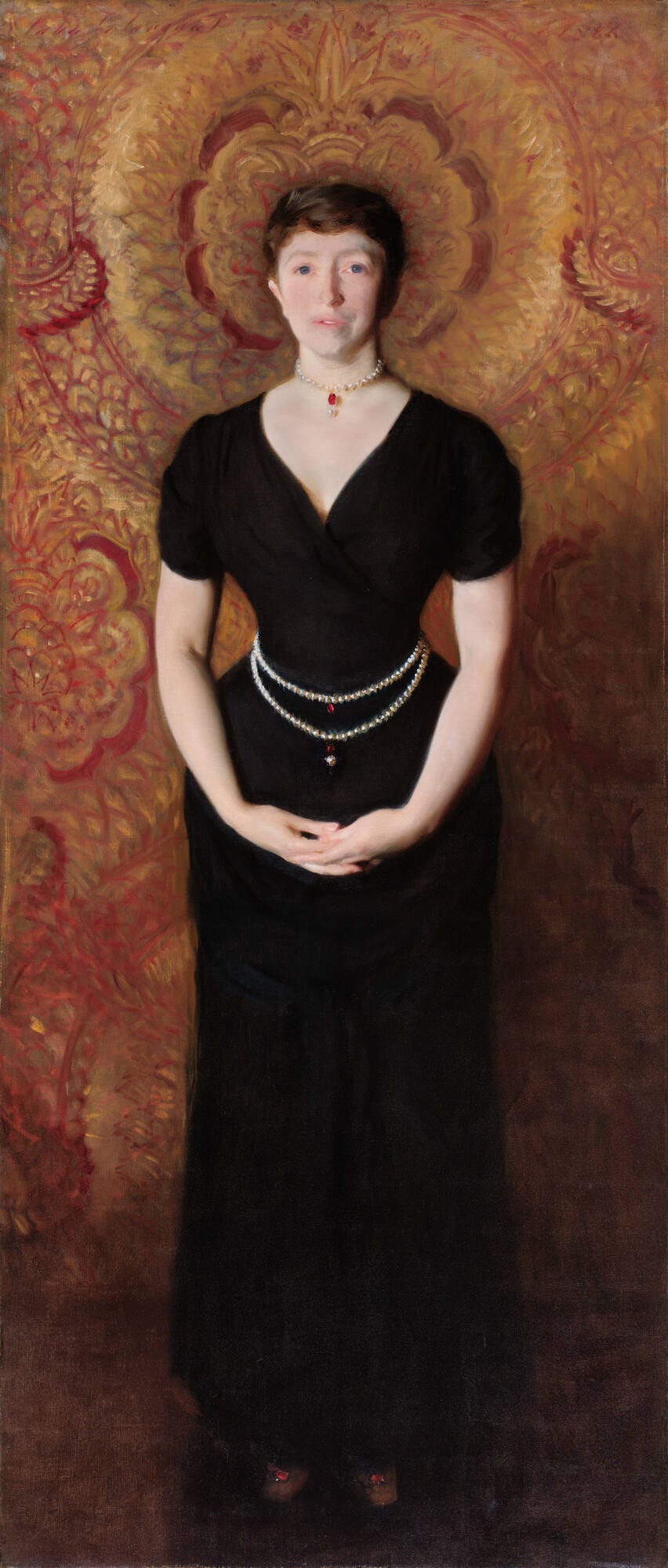
For more insight into Isabella and the glorious Gardner Museum, we’re rolling back in time to our sit down with Diana Greenwald, the William and Lia Poorvu Curator for the Collection at the Isabella Stewart Gardner Museum at Petit Robert in Boston’s South End.
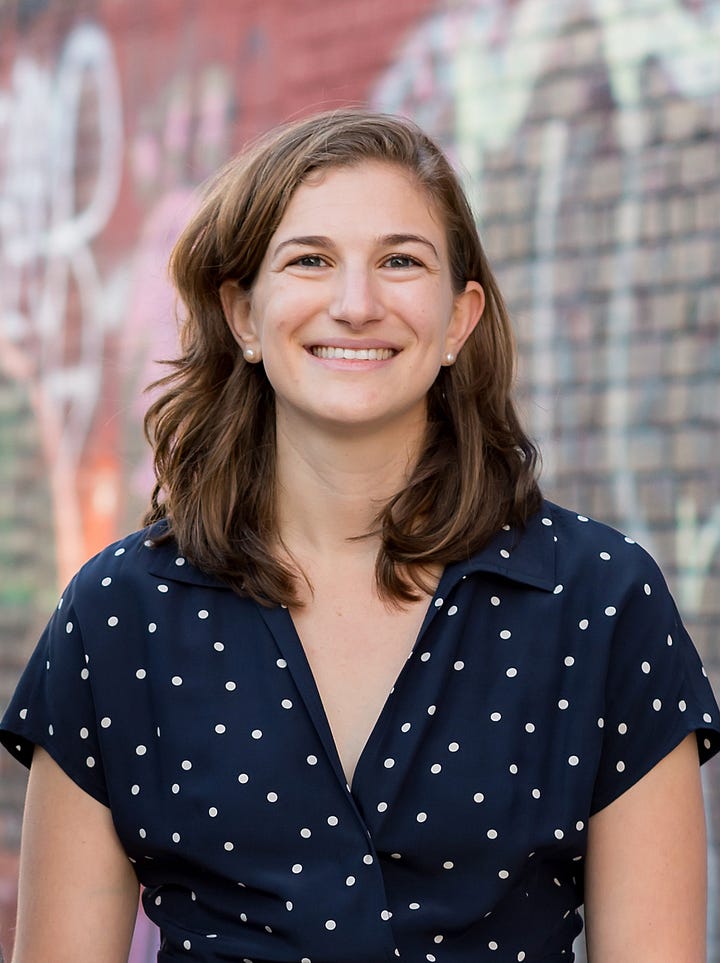

20 November 2023, Boston, Massachusetts
LLW: Diana for our Readers, would you introduce yourself? And share what it is that you do?
DG: My name is Diana Greenwald, and I am currently the William and Lia Poorvu Curator of the Collection at the Isabella Stewart Gardner Museum in Boston. I am both an art historian and economic historian by training, and in my academic work I use both statistical and qualitative analyses to explore the relationship between art and broader social and economic change during the nineteenth and early twentieth centuries, particularly in the United States and France. My first book, Painting by Numbers: Data-Driven Histories of Nineteenth-Century Art (2021), deals with this.) At the Gardner, I am kind of a jack-of-all-trades because I manage our Collections team. To date, I have organized five exhibitions on subjects ranging from Maurice Sendak, to Isabella Steart Gardner’s travels, to the contemporary artists Betye Saar and Fabiola Jean-Louis. I have written, co-authored, or edited a range of exhibition catalogs and books at the Gardner including Betye Saar: Heart of A Wanderer (2023, editor), Fellow Wanderer: Isabella Stewart Gardner's Travel Albums (2023, co-editor with Casey Riley), and Isabella Stewart Gardner: A Life (2022, co-authored with Nathaniel Silver).
Before joining the Gardner, I was an Andrew W. Mellon Postdoctoral Curatorial Fellow at the National Gallery of Art in Washington, D.C., working in the departments of American and British Paintings and Modern Prints and Drawings. I received my doctorate and master’s degrees at Oxford, and did my undergrad at Columbia.
LLW: Wonderful, thank you for that. To give additional context to your role at the Gardner: What did you do today?
DG: [laughs] What did I do today! Oh my gosh, what did I do today? [Pauses] I had a breakfast meeting with someone interested in setting up tours, in a new way at The Gardner. After that I worked on writing labels for an upcoming exhibition about Édouard Manet1.
LLW: Fun.
DG: We’re doing a show in October 2024 about Manet’s family, his images of his family - we own a really gorgeous portrait of his mother2.
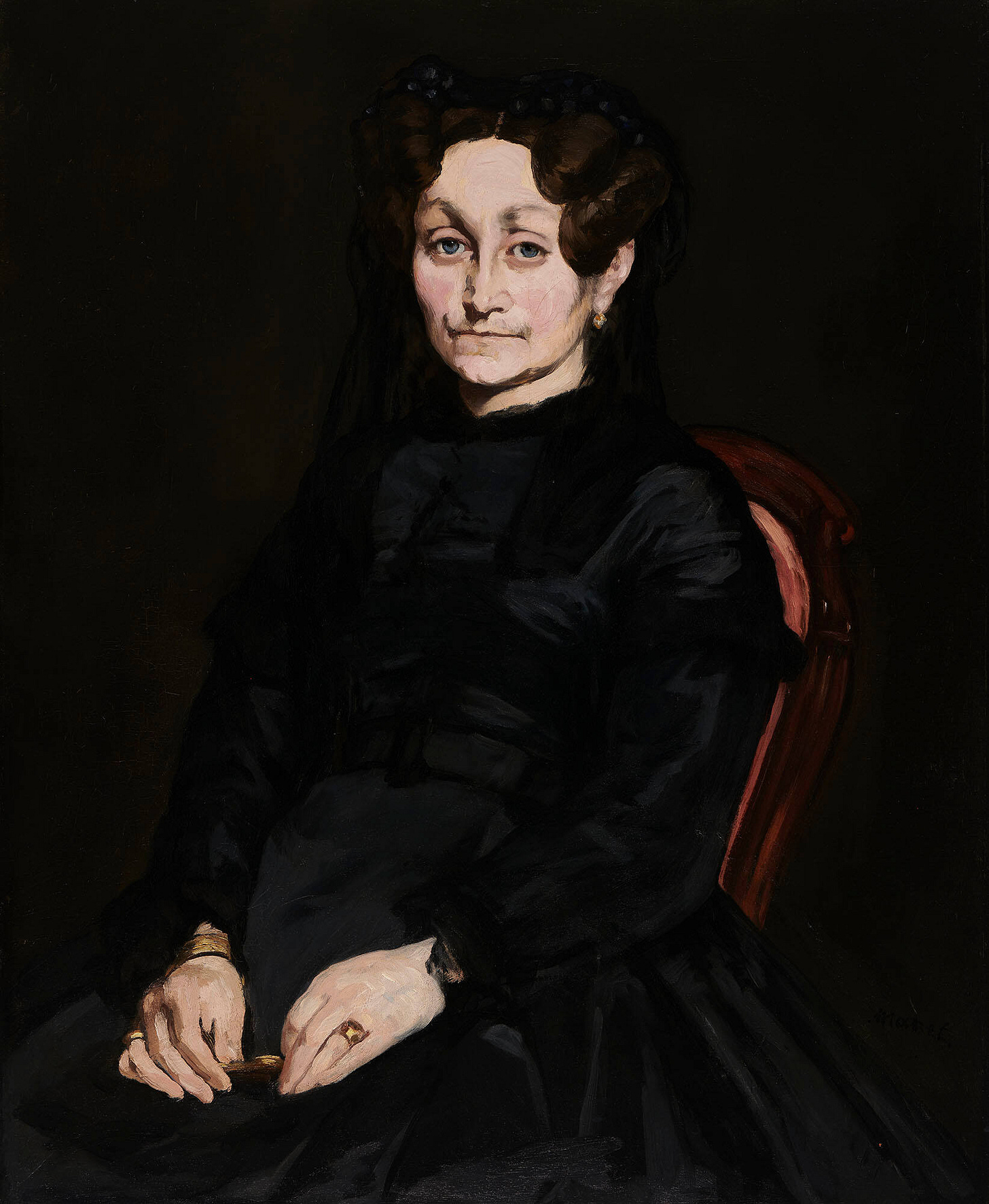
LLW: That’s an interesting, new angle on him.
DG: Yeah, I think so. He had a complicated family, in that it was really happy in some sense however it became complicated due to questions surrounding the paternity of his wife’s son, Léon.
LLW: Woah, juicy.
DG: We don’t have to go down the whole rabbit hole, but it’s unclear who Léon’s father was and one of the candidates is actually Édouard’s own father, which would make him both his stepson and half brother, if that is the case. And Édouard’s wife3 was a Dutch piano teacher who worked with his fancy Parisian family…This all sounds horribly scandalous but they were really happy. His family was important emotional and financial support for him in addition to being his most frequent models.
LLW: The French!
DG: There was a book written about this in 2001 by a wonderful scholar named Nancy Locke4, she's a professor at Penn State, but there has not yet been a show about it.
[Petit Robert’s team interrupts to deliver our piping hot twin glasses of vin chaud. We take a sip.]
LLW: Wow this is very nice.
DG: Really refreshing.
LLW: Mulled wine can be such a hit or miss sometimes.
DG: I did try to make mulled wine, the first time, as an undergraduate it was very bad…very bad. I just dumped some sugar in it.
LLW: [laughing] Like a Ratatouille moment!
DG: Yes! Except not as good as the rat.
DG: So that [show] is about a year out, and we are starting to go into exhibition design and part of my process for how things need to be laid out…the catalog is already in production but I will write labels to think through if the sections [of the exhibition] really work….I also gave a tour for City Councillor Sharon Durkan, who represents the district that the Gardner sits in, and that was really interesting.
LLW: Very cool.
DG: While she was already familiar with the Gardner, it was a chance to share with our elected officials what the Gardner does for the city, how important it is and what an attraction it is…[During that visit] our leadership team was also able to point out some of the improvements we have made for climate resiliency.
LLW: Awesome - what are those?
DG: For example, our lights are all being swapped to LEDs, our central Courtyard garden - which is incredible - our Head of Horticulture has been moving nearer to almost a pesticide free existence.
LLW: Nice.
DG: So that was a cool visit, and then I had lunch with our Assistant Curator, who is awesome. She works on Asian Art, her specialty is Chinese art, but she looks after our entire East Asian art collection - so we had a check in lunch.
LLW: Interesting.
DG: I had some meetings related to planning for some upcoming conservation projects. We had some great questions for them about how to interpret for those upcoming projects.
LLW: Great to hear how supportive your wider organization is - must be critical to getting done what needs to be done.
DG: Well one of the things about the Gardner is the sense that it doesn’t change. Because of the will…
LLW: Isabella wanted it to stay exactly as she hung it basically. Right?
DG: Yeah, so we’re not supposed to change the general disposition. Now, of course, things have disintegrated over the course of time, certain things, like wall hangings in particular, as we didn’t have climate control until the 90’s…things degraded. [Over the years] we have gone through several, what we call, whole gallery restorations using historic photographs and inventories to get closer back to what Isabella intended. So we were working on one of these conservation projects today.
LLW: So fascinating, working to keep the entire Museum preserved without changing things. Huh.
DG: And now I’m here.
LLW: Quick question about the conversation projects you and your team work on: Did you recently restore the Titian Gallery? Those rooms are incredible. So sumptuous.
DG: Thank you - they do look great. Titian is the most recent Gallery that was restored. It was completed in 2021.
LLW: I want to live in that red color. It’s so nice.
DG: It’s amazing…[The gallery] used to be just one uniform maroon color and it turns out, from a photographic campaign completed right after Isabella died - she was very good about photographing the Museum for future reference of how the galleries were organized - and we worked with a traditional textile manufacturer, Prelle, who creates textiles in Lyon, France to reproduce what was supposed to be on the walls based on scraps we had in storage.
LLW: Wow!
DG: So the Titian and Raphael Rooms, among others, have all been restored…We also have a re-lighting project going on.
LLW: You walk in those rooms and it’s just, glorious…The experience of moving through those rooms, and looking out into the interior Courtyard. You’re flanked by these darker rooms and standing within these pockets of bright red [within the Titian gallery]. It’s crazy. The Museum on the whole is a beautifully designed experience.
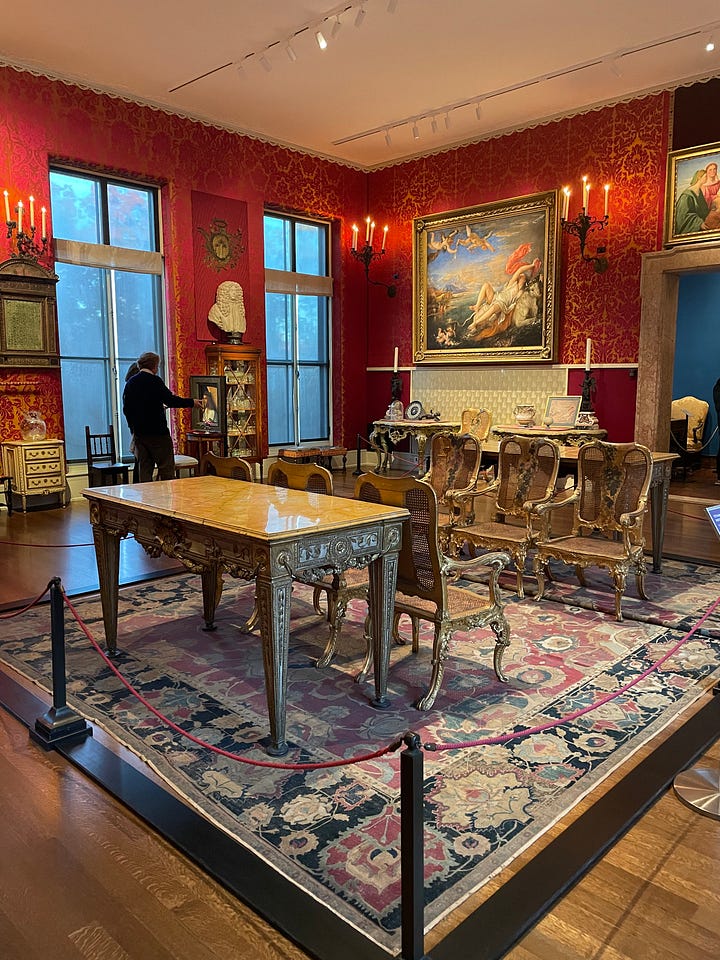
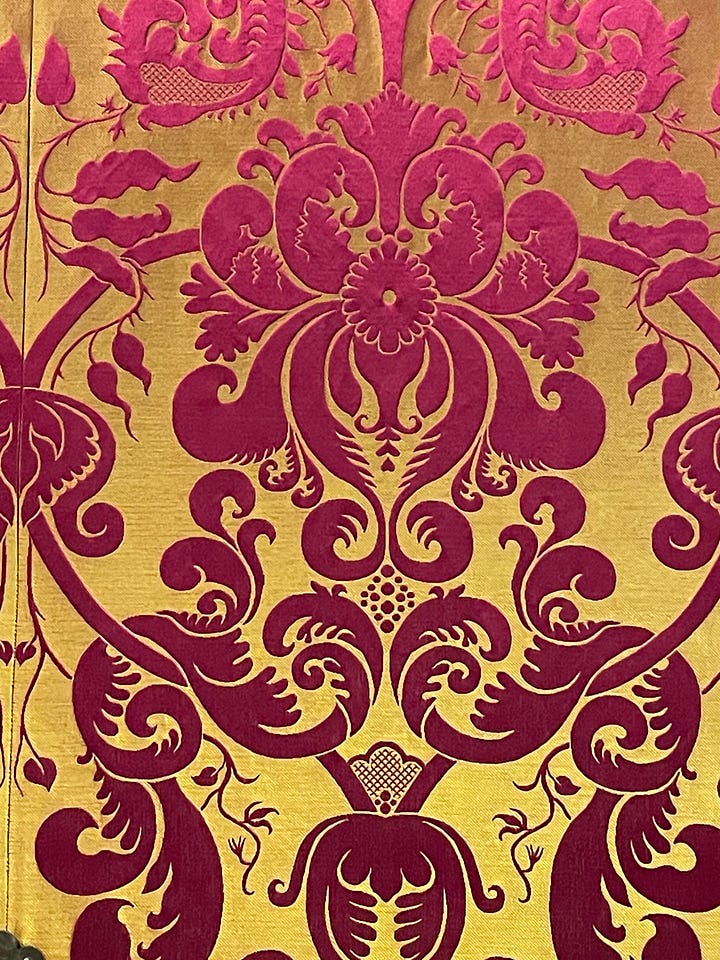
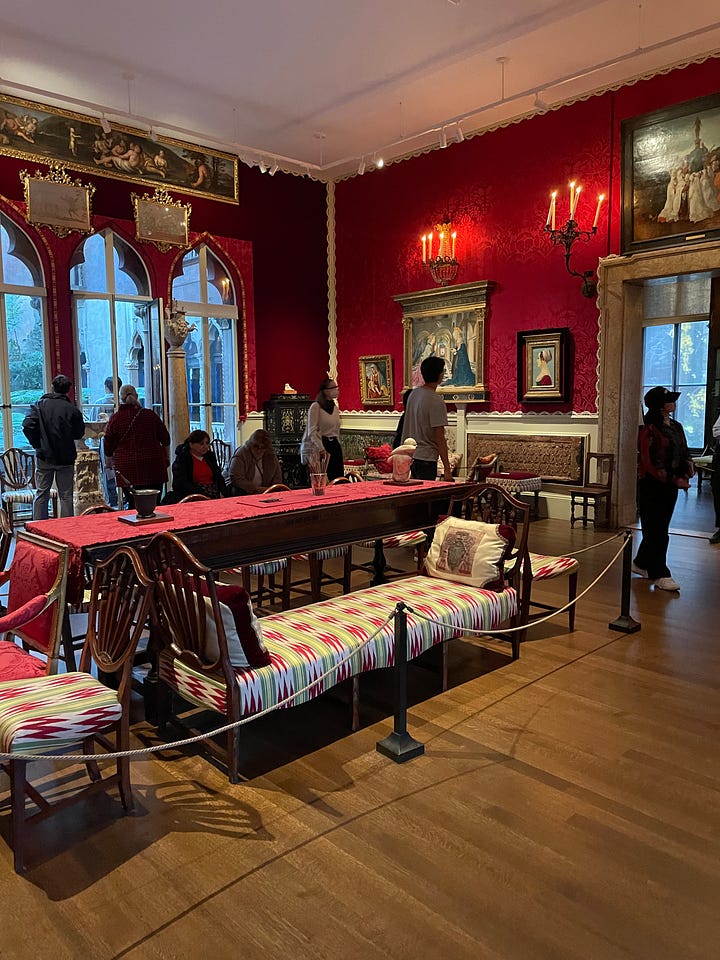
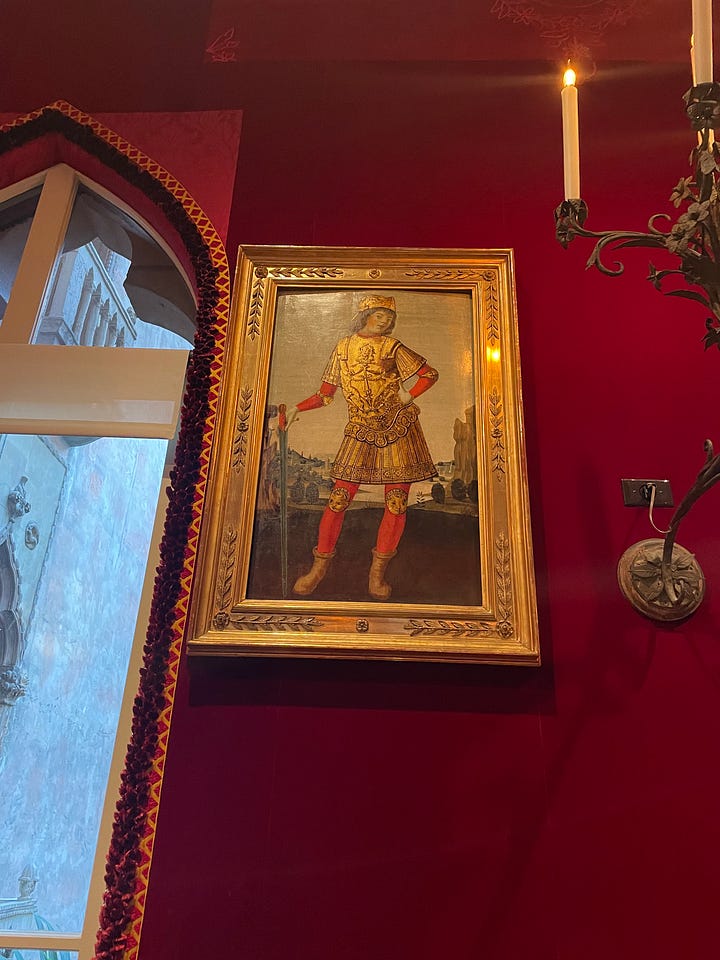
DG: I often joke that Isabella is the ultimate chief curator and my ultimate boss. She was very good at all of it.
LLW: Clearly, and you can see her travels in it. I walked around and the way she experimented with and manipulated light and wall hangings and architecture. I certainly see Venice in it all.
DG: It’s funny, because the Museum is ‘Venice’ and she traveled a ton between 1867 and the early 1890s, but interestingly this was mostly before she started working on the Museum.
LLW: Is this when she was beginning to collect?
DG: No! That’s what is so fascinating. Sadly she and her husband, Jack, suffered the loss of their 2 year old son, Jackie, in 1863, and to cope with the loss they began to travel. So they went to Scandinavia and Central Europe, first. Then they went to the UK, all over Europe and the big trip: they went around the world, literally, in 1883 and 1884.
LLW: Incredible.
DG: They went to San Francisco, crossed the Pacific to Japan, China, all over Southeast Asia. She went to Angkor Wat5 in 1883.
LLW: Visiting Asia in the 1800s must have had a great impact on Isabella. I mean, I lived in China 8 years ago, with technology, and it was a crazy, life changing experience in the 21st century! I imagine a woman visiting Asia during the Gilded Age. Just...what a woman.
DG: Super impressive. She was incredible, and I think, very intrepid. During these travels she had very frank experiences and became interested in Buddhism and other religions. She travels with her husband to India after China and she is interested in Hinduism…and what I think is so interesting is that the first time she goes to Venice, as an adult, is in 1884 after spending 3 months in India…and they travel to Venice from the East.
LLW: Wow.
DG: And what Venice looks like, coming from the better part of a year spent in Asia, versus on the Grand Tour6 is really interesting.
LLW: Yeah, the difference that journey would make in her perspective.
DG: I really view the Gardner as a global collection, and there is a real generosity of trying to share that experience of travel and being transported with visitors in Boston. [Diana pauses thoughtfully] There are all of these different moments [within the Museum] that you can connect with and all these different influences to which you bring yourself and experience and while it might stay largely the same, the people experiencing the collection are different and those people change and become different over time…I notice something different in the Museum everyday.
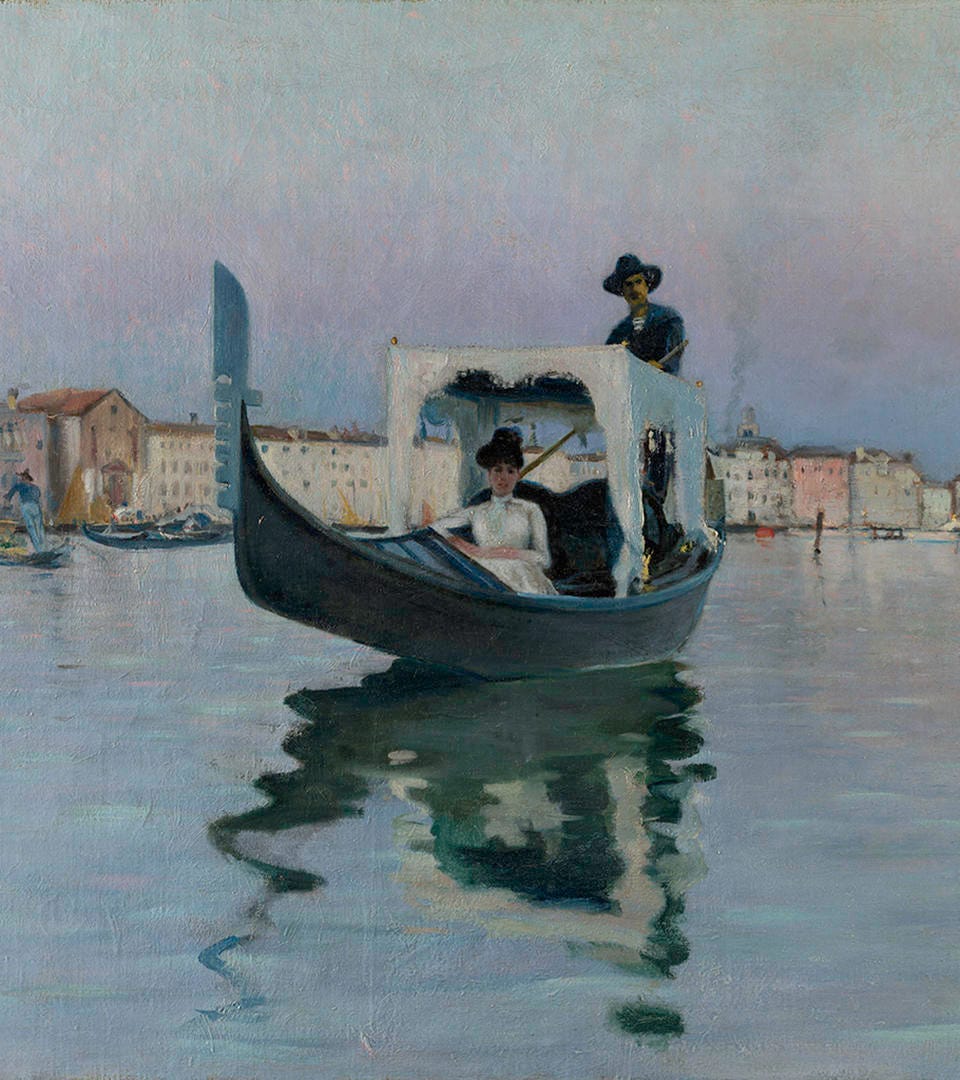
LLW: For sure. I imagine people like the fact that it’s sort of like a house museum, and while it’s not, the Museum has the experience of feeling like you're visiting a special place, enjoyed by people, almost lived in, as it is so well organized and thought out. And maybe that comfort…I also noticed, during my visit today, that there are so many different types of visitors. All ages, backgrounds, professions, different languages being spoken. That felt unique.
Also! I kept thinking of The Gardner as an attraction…if I only had a day in Boston and didn’t speak great English, I would likely more enjoy a tactile experience where I could interpret the art versus trying to read a million labels.
DG: I could see that, absolutely.
LLW: It's funny, I always have prolific museum experiences when I come to Boston.
DG: [Laughs]
LLW: I have a distinct memory of MFA’s7 William Merritt Chase exhibition…It was a long time ago. It so inspired me that I wrote a thesis, when I was applying to Master’s programs, on him.
DG: Of course! I remember that show.
LLW: [I digress] Another thing I was surprised and impressed by in today’s visit is how few ropes and red tape there is at the Museum. Visitors can get quite close to the art.
DG: Very very close…Our Conservators think about this a lot [insert small laugh here].
LLW: It’s amazing, and what was impressive is that no one was touching the art or too close, everyone respected it, even without being explicitly told to do so. There was a reverence and that fascinated me. Speaks to the experience Isabella created and that has been upheld by your team.
DG: She was a religious person and interested in other religions too, and a lot of the artworks she collected were for spiritual use…and while the building is secular, I think what that tells you is that she was trying to create a place to encourage that reverence, something that could transport you and feel spiritual. That seems to resonate in a secular age with lots of different audiences and ages…Almost like an easy entry point to come in and be awed.
LLW: Yeah! Great way to put it.
DG: It is a privilege to work in a museum where you feel the founder was on to something.
[Diana and I take a pause to enjoy the most delicious truffle fries]
LLW: Your background is really interesting, I am captivated by your qualitative life and time spent with both numbers and art. You’re an Economic Historian, right? What does that mean?
DG: That is true, and a great question. I often say I am odd because I love spreadsheets and numbers and I love art. I always was interested in economics in addition to art history - full disclosure, my father is an economist so it was always around, as were museums growing up in New York City. My parents always took me to museums…they were always my happy place.
I was always interested in both and trying to do both, and in my senior year of college, I applied to a bunch of fellowships that would have brought me to the UK. Didn’t get the fellowships, but got far enough along in the process that I actually had to apply to schools…and I applied to economic and social history programs.
LLW: Cool.
DG: Which is actually a distinct discipline within the UK. So I got into a Master’s program at Oxford and ended up going. Often people think economic history means the study of financial things, like markets, money, however it can also be the use of quantitative methods to study historical subject matter.
LLW: Huh that’s fascinating.
DG: It’s cool, and people don’t realize it’s a distinct field and method. I got really interested in how data could capture all of these things that we couldn't see in the art world…It became pretty clear to me pretty quickly that when you look at lists of things, for example art exhibited, it is obvious that all this art shown in the 19th century is nowhere to be see nowadays. [To put it more broadly] when you visit a museum collection you are seeing the tiniest, tiniest, tiniest piece of what was produced by artists.
LLW: [Pauses] Woah, that is insane. If you think about it, kind of mind boggling.
DG: It’s crazy! And you sort of don’t realize it. The great thing about printing technology and the press in the 19th century, for example, is that you have lists of all these works that were shown at the time, you know the titles. So [as an Economic Historian] I found this list of all this work shown at the Paris Salon and turned them into a data set, then I found another list and made more data sets - I ended up staying [at Oxford] for my doctorate. Through all of this you can suddenly start testing how trends in art respond to social and economic change, you can interrogate yourself to understand if what you thought was a trend was actually a trend in the population of work [at that time] or is it just that you are working off of a very biased little sample.
LLW: Nuts.
DG: I had this zany idea and they let me do it. The nice thing about Oxford is that it is so old, that it was actually easy for them to accommodate an interdisciplinary doctorate…and so I got to do both.
LLW: Wow.
DG: It’s funny people often assume, from my academic background, I wouldn’t want to be a curator because they deal with objects and not numbers, and that’s not true at all. What’s interesting is that the Gardner makes a point that I can make with graphs about how limited the view is that you get in other museums of art that survives and is shown, because we have everything on view - all the wild stuff Isabella collected.
LLW: That’s true and something I hadn’t thought about. Your collection isn’t sitting below stairs collecting dust.
DG: No, and it’s not all that curated by our team. In the modern space, yes, but in the historic space, no. One of my favorite works is this pine cone8 on a piece of driftwood. It's on display, Isabella put it on the edge of the Courtyard. At another museum that may not have been accepted or might be in storage.
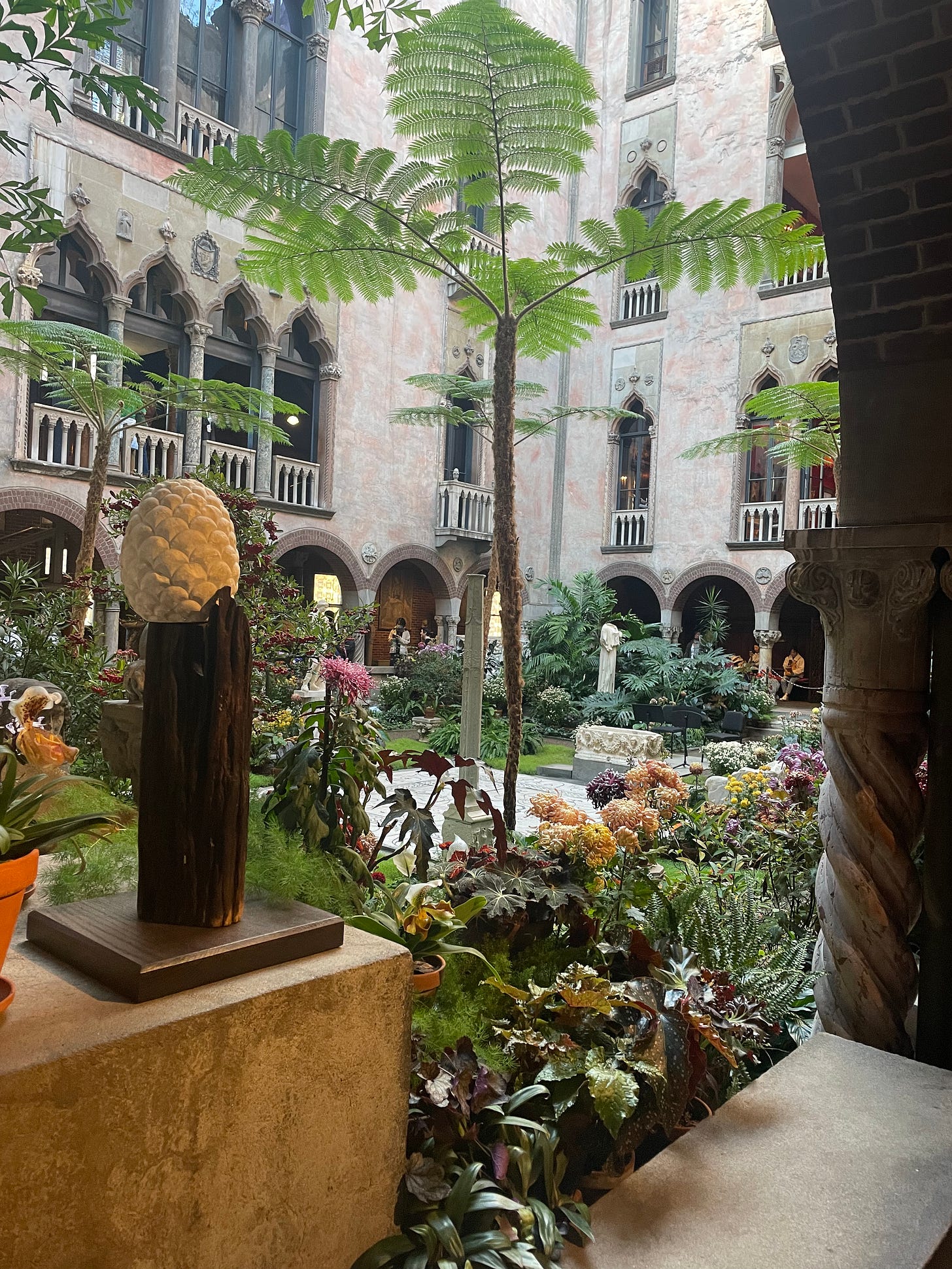
LLW: Yeah.
DG: The Gardner makes this point that I can also make with spreadsheets, for example, look at all this art that was shown in New York between 1800 and 1880 and you may have thought there were almost no women artists, but there were tons of women. They just had not made it through this filtering process into an institution like The Met.
LLW: Such an interesting perspective. I’m curious how you came to be at the Isabella Stewart Gardner Museum? Can you tell us a bit about that?
DG: I was on a Post Doc at the National Gallery of Art.
LLW: Ugh, my favorite museum.
DG: Love that museum. I love DC, too.
LLW: Same.
DG: My husband and I were in Boston for a friend’s wedding - it was the summer of 2018 - and I had actually never been to The Gardner and neither had my husband, so we visited before flying back to DC. Visiting I was just overwhelmed and wowed, and my husband who likes art but doesn’t work in the arts said, “It would be cool if you worked here.” Six months later, I kid you not, the Museum posted a job.
LLW: Wow, he manifested it!
DG: It is a pretty sweet gig.
LLW: Gardner Museum is incredible, like, perhaps the greatest museum in the world? Truly. What is your favorite part of the Museum? Do you have a favorite work of art here?
DG: Oh man. It’s so hard to choose a favorite object, there are so many great ones. I’m a 19th century person, so I am very biased. Our Sargent9 watercolors are incredible…Gosh [thinking] our Manet is incredible.
One moment that I came to really admire Isabella is around John Singer Sargent’s El Jaleo, which is one of our masterpieces. What people don’t always appreciate is first, she didn’t own that painting when she built the space for it [at the Museum]. In 1903, she created this space called the Spanish Cloister, specially designed for El Jaleo. She convinced the owner [of the painting] to sell it to her, basically, based on the fact that it would be perfectly displayed in the space she designed for it. [Pauses] Sargent’s El Jaleo is a really exoticized image of Spain. It’s set in Southern Spain around Seville and Granada. It's supposed to depict a Roma dancer dancing, and she creates a space around it, which has quite a sophisticated understanding about the way it's exoticized and that Spain is a complicated place. For example, she has a tile from Sevilla, a mihrab tile from a mosque, a Turkish iznik tile, a Roman urn - all of these histories of Spain.
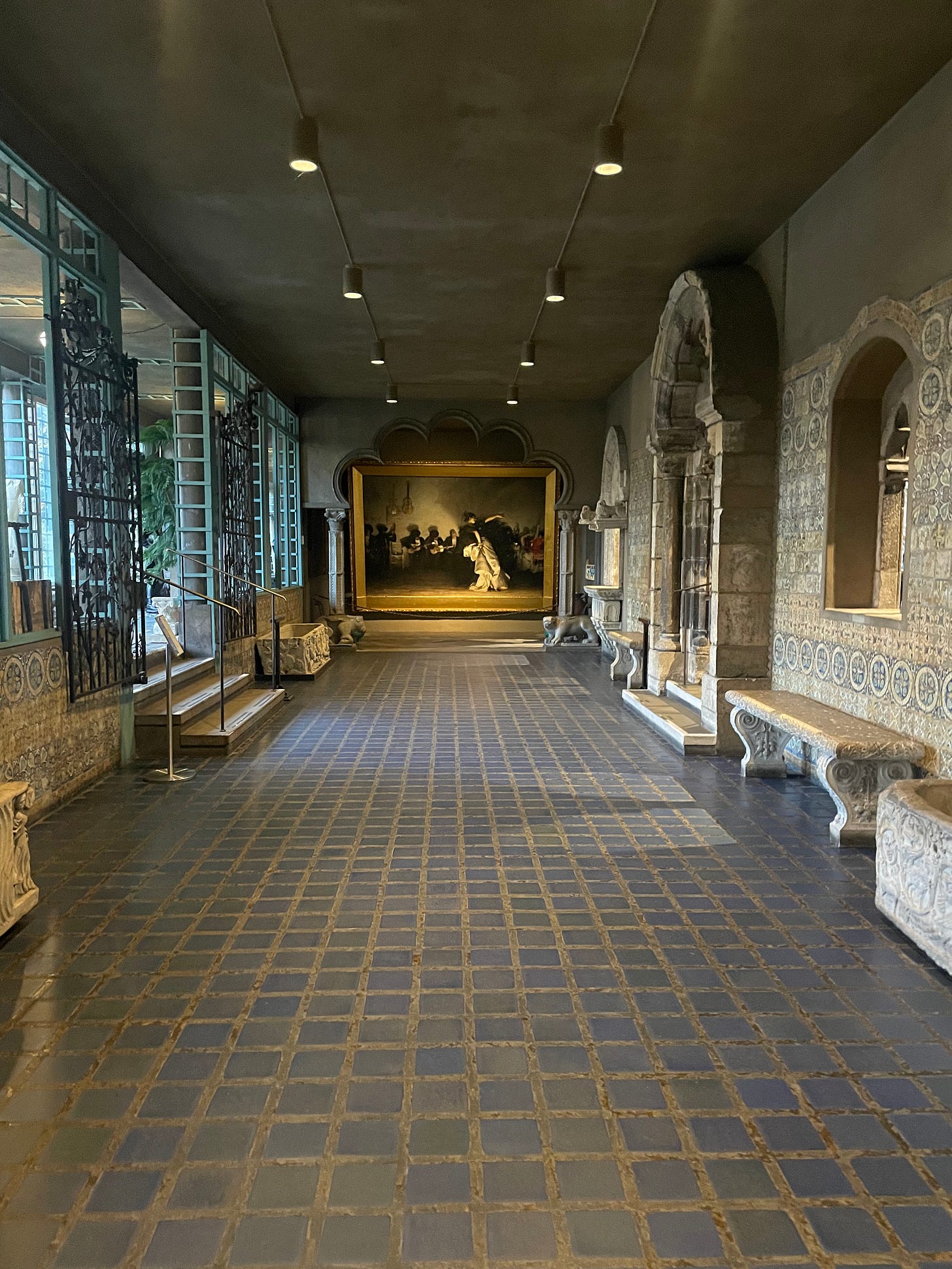
LLW: Remarking upon all the people who have been part of the tapestry of Spain.
DG: Exactly. Its Islamic and Roman past and how they feed the Spanish present. The arch around the painting is very much similar to the Alhambra, and as if all of this were not enough on the walls she ends up putting in talavera tiles that are a Spanish method of making but made in Puebla, Mexico under Spanish colonial rule.
LLW: So impressive, this 19th century woman from Boston is interested in all of these nuances and is thinking about Mexico and Islamic people of Spain and so on.
DG: It’s super interesting that she would be interested in these topics and introduce them into her curation of the space…It’s such a complex understanding of Spain and the way she’s putting different objects in conversation to represent challenging geographies and legacies. It’s amazing, one of my favorite installations of hers.
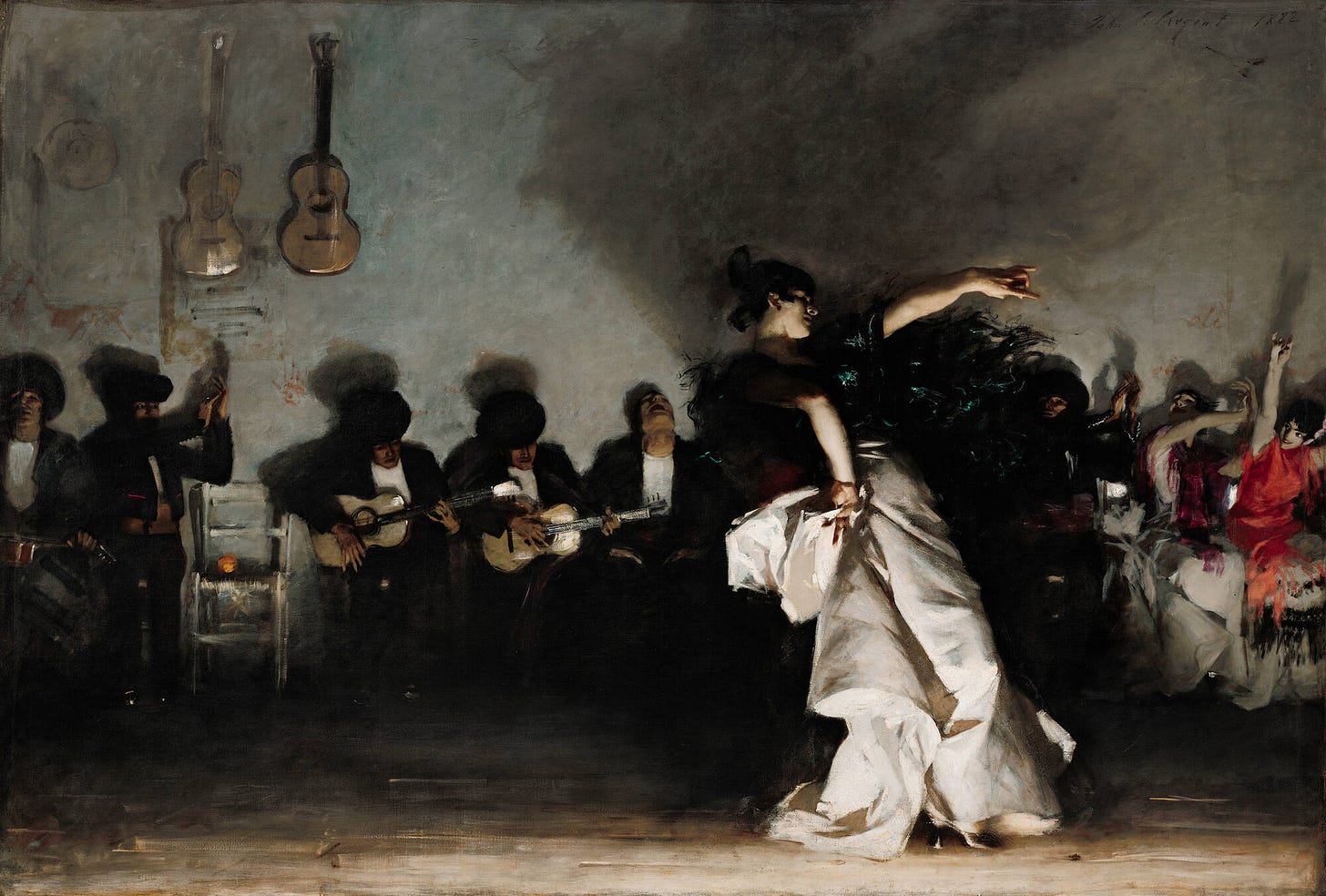
LLW: For our Readers, how do you recommend they experience the Gardner? Where should they start?
DG: My tip for when people visit the Gardner: that space I just described is on the first floor, but while you’re going to want to stay on the first floor for a little bit, take it in and then go to the third floor and work your way down.
LLW: Interesting. Why do you say that?
DG: Honestly, crowd control. The first floor is very busy and there is something really wonderful about seeing the Courtyard from above and getting closer and closer to the greenery.
LLW: When I was in the space this morning, looking down into the center of the Courtyard looking down at Medusa mosaic, all I could think about was courtly love. It made me feel like I had time traveled to Arthurian times and I imagined myself in a glorious dress…the whole thing.
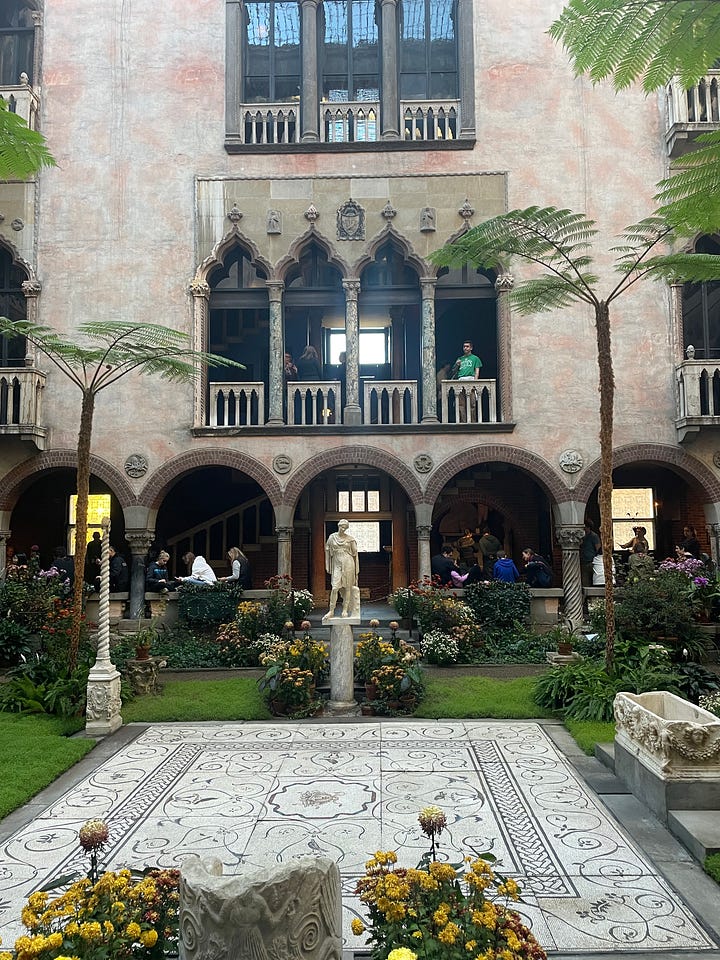
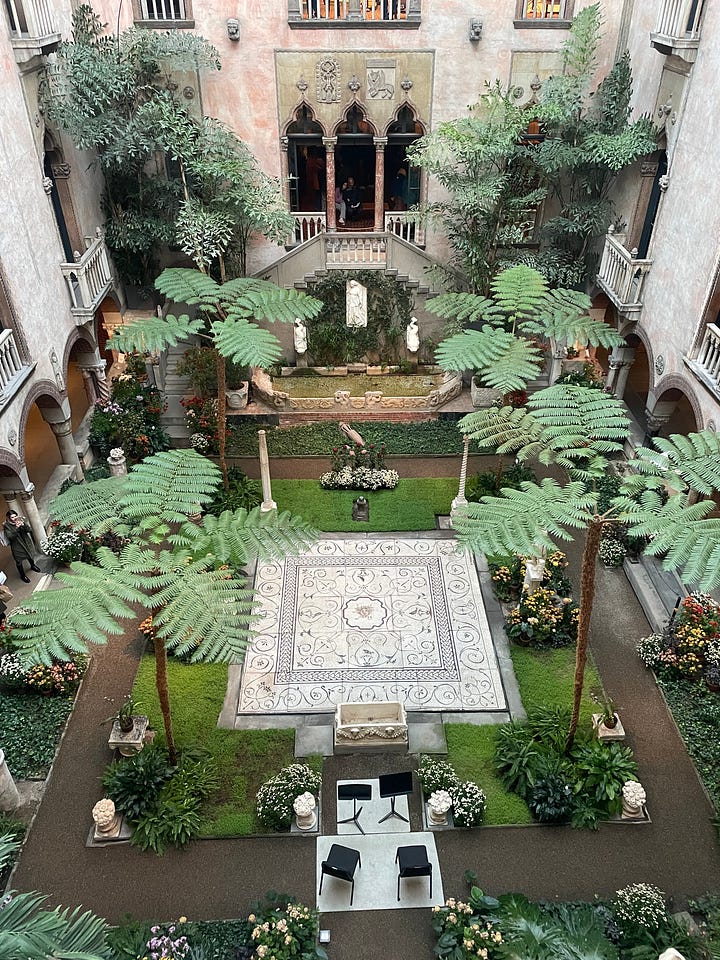
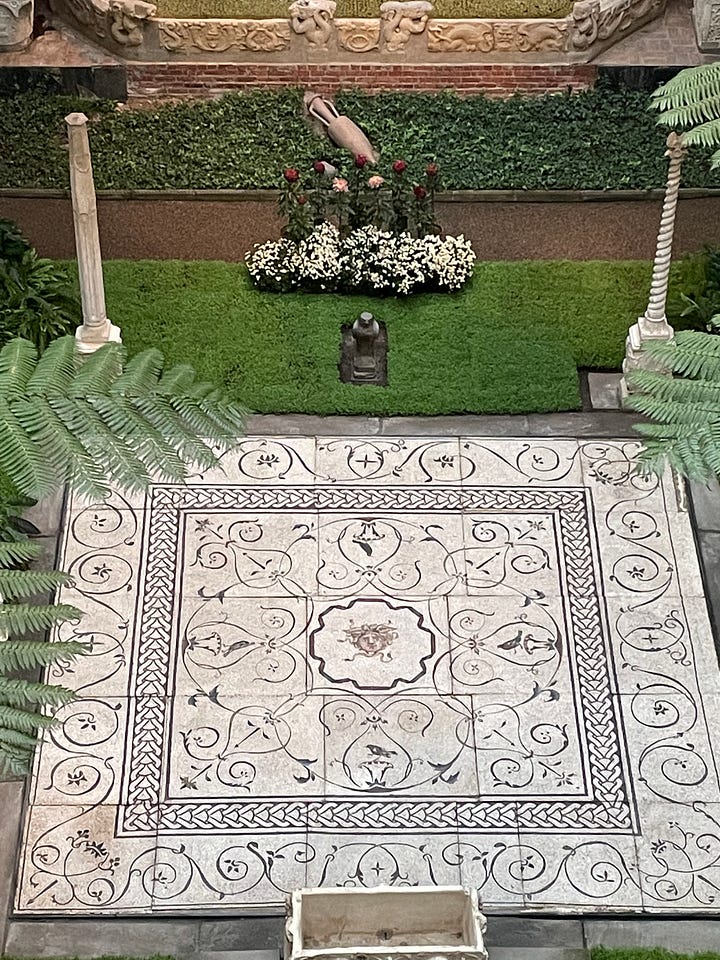
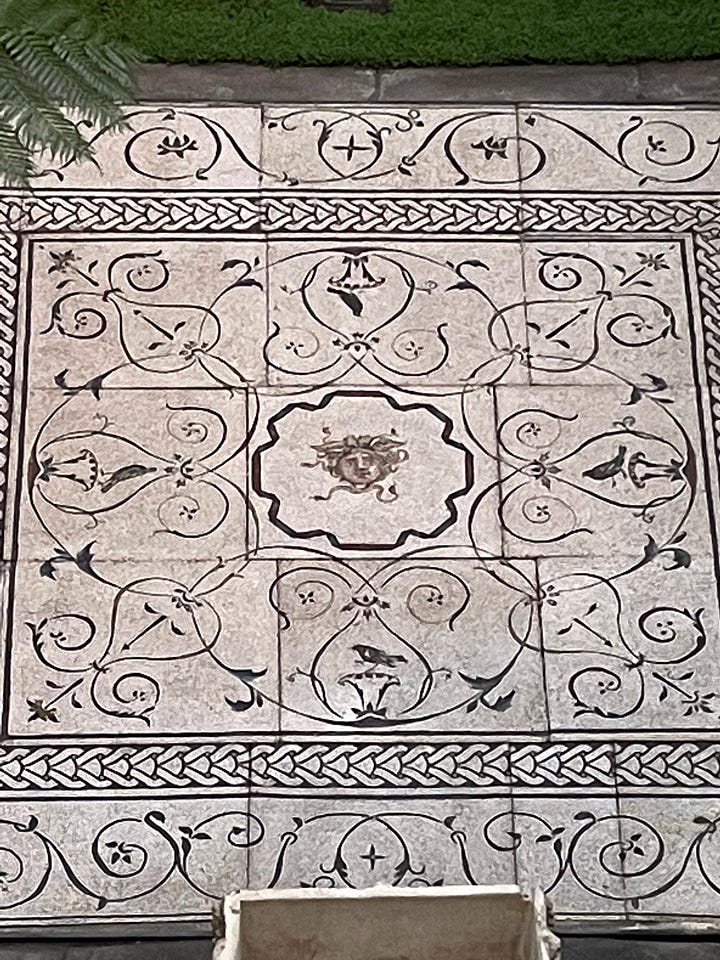
DG: You’re not the only one who feels like that, people come in dressed to the nines to have their photos taken…Isabella created a setting that invites people to fashion themselves in creative ways. Very prescient. Particularly in this Instagram, social media era where people are more focused on the experience.
LLW: You mentioned this earlier, but I’d love to revisit. When did you know you wanted to be a curator?
DG: My parents were great, they always took me to museums. We often went to The Met, for “dinner”. Looking back I am pretty sure my parents had dinner with me at 4.00pm [laughing at the memory]. So we would go to the cafeteria and to the galleries and I would draw and explore. I often joke that my career was destined to be because when I was 3 or 4 [years old] I actually fell into a fountain at The Met.
LLW: NO? No!
DG: A fountain in the American Wing and I ended up being an intern in that department in college. It was like this weird art baptism.
[We both laugh]
But really, I remember as a kid, maybe 9 or 10, reading a book about a museum and their description of the job of a curator…and I thought that sounds so cool. I was lucky enough to go to a high school that offered art history.
LLW: I did too - changed me.
DG: It’s a huge gift…I studied art history in college as well as Econ. I waffled a little bit considering other careers, but what really confirmed the choice was when I was an intern at The Met there was this moment when we were talking with this veteran educator and he said this thing that really impressed me, as a native New Yorker, that the city is always changing, this restaurant or shop goes and neighborhoods evolve and the city is a transient and quite chaotic place but The Met is always there. It doesn't mean it’s unchanging but it is this fulcrum around which everything else can spin and it feels stable…And I think that’s what museums can do for people.
LLW: Beautiful.
DG: The Gardner does that better than almost any other museum. I really like being part of keeping that fulcrum safe and relevant…Though I still am very proudly a Yankees fan even though I now live in Boston.
[We both chuckle]
LLW: I am curious, what was the first work of art you fell in love with? Do you remember?
DG: Yeah. I do. The Bellelli Family. It’s currently in New York, owned by the Musée d’Orsay. It’s an early Degas10, created between 1858 - 1867. It’s this amazing portrait of a cousin of his, who was in an unhappy marriage and you can really see that, it has an incredible psychological dimension. It’s huge. We talked about the painting in my art history course in high school and I saw it on the slides, in class, and I was struck by the way Degas was able to capture these psychological dimensions of a family that was fraying at the time…When I was 14 or 15, I had the privilege of visiting Europe with my parents and they took me to Musée d’Orsay and I turned this corner and saw this painting and it floored me.
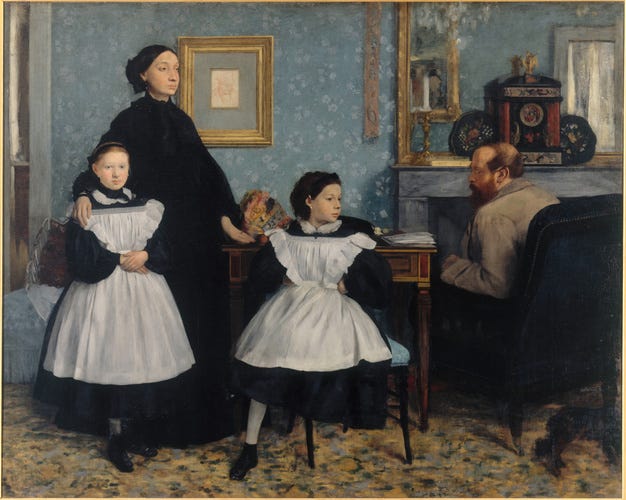
LLW: Magical.
DG: I had a professor in college who was a Philosopher of Art and she called it the aesthetic experience. I think that’s what it was.
LLW: And for those who are considering a museum career or shifting sectors, any general advice to someone who wants to get into this world?
DG: There are a couple of things, first, there are lots of jobs in museums that are not being a curator. People don’t realize how much being a successful curator is being part of a successful team. The exhibition planning team manages contracts, money logistics around special exhibitions…but it’s also the other teams: education, development, interpretation and accountants! Museums are enterprises that employ a lot of people, from the front line staff to my team. Don’t think the only way you can contribute to a museum is to be a curator. I am nothing without the rest of the team.
Second piece of advice: if you want to be a historic curator you need a PhD. It has become basically standard…and it’s a lot of school and I had to do unpaid internships, at first, which is luckily going away. But it’s a different path, you won’t have a 401k until a certain moment in your career. You have to go to a lot of school and it’s a big investment.
The last piece: you will probably have to move for a job. Some people don’t always understand this, but it’s very rare for curators to find a job in their dream city.
LLW: It’s important to have insight into what's required of a role.
DG: And if you’re open to working in other parts of the museum, there will possibly be more opportunities in your dream location.
LLW: I very much respect the perseverance and all the energy that goes into doing what you do.
DG: Sometimes curators get outsized credit or attention but it is a village. We couldn’t do it without everyone on our team.
LLW: Thinking about your wider team, what exhibitions, in addition to your research on Manet, are you working on at the moment?
DG: What’s great about the Gardner is that we have a very dynamic exhibition schedule. We turn over all 3 of our exhibition spaces 3 times per year.
LLW: That’s a lot of newness!
DG: So I’m always working on shows.
LLW: What is your process for building and executing exhibitions like?
DG: We have a great process at the Gardner. I did not create it but I am glad to be part of it. We plan 3 - 4, sometimes 5 years out. There is always an initial pitch phase where we pitch the show internally, to colleagues and our Director, and if the idea moves on from there we begin discussing the feasibility of loans11 from other collections.
LLW: Mhmm.
DG: We also have a very involved interpretative process, particularly with shows that might have a community impact, for example we will do round tables and consultations.
LLW: That’s great!
DG: It is great. It makes me a better curator. I did this show about Isabella Stewart Gardner’s travel albums in concert with a show I did about Betye Saar12 and her travels and how she was inspired by travel. Interestingly, Betye was born only 2 years after Isabella died, and they went to many of the same places and Betye loves the Gardner. She views Isabella as a fellow installation artist…During this show we worked with a series of outside contributors who were experts in the geographies we were highlighting.
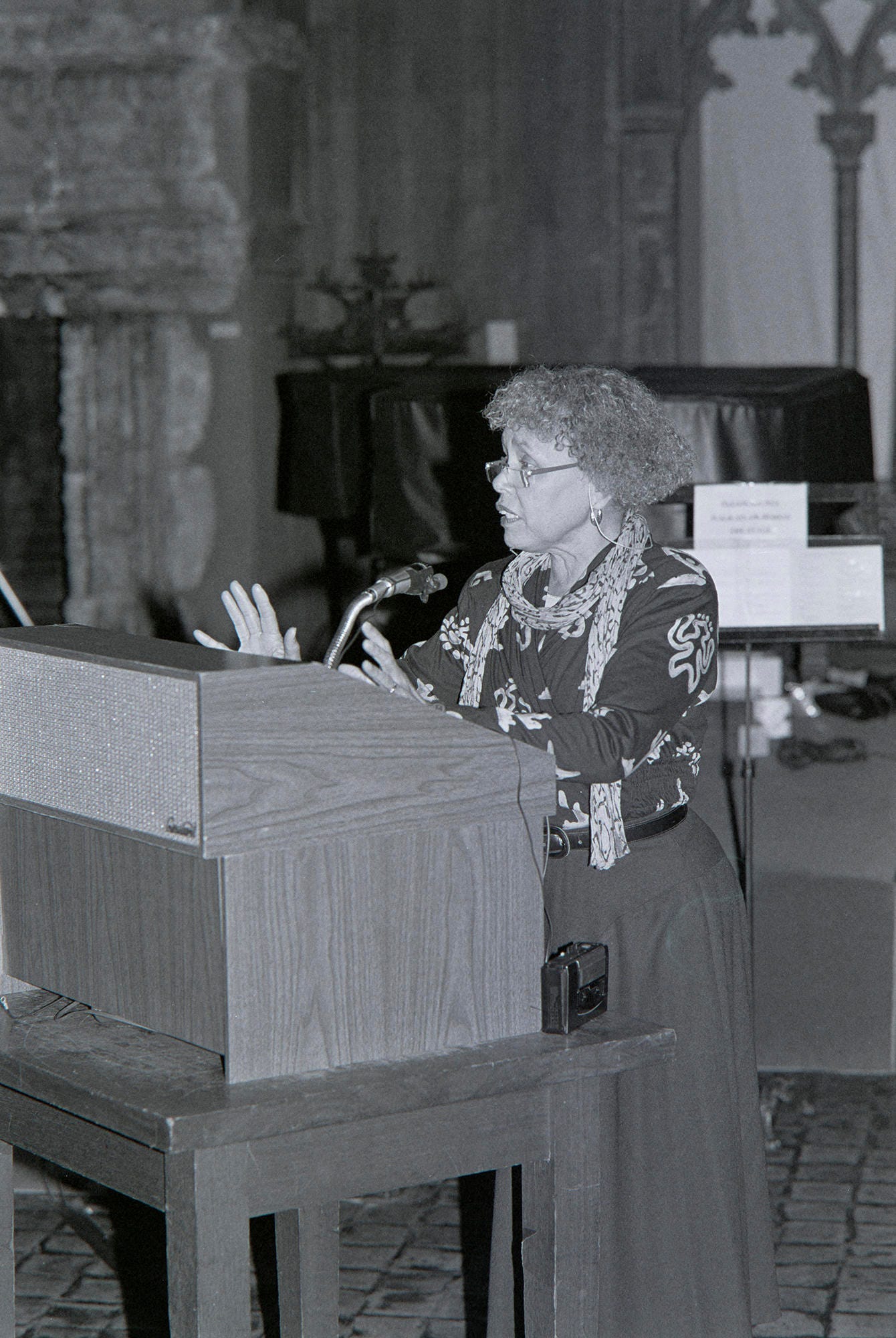
LLW: Fascinating. How did you find those experts?
DG: It’s a network, some are from previous round tables or catalog projects. It’s usually a 2 year long interpretative process to ensure we are doing things in a way that is inclusive and thoughtful…bringing more ideas to the table just makes things better.
LLW: Totally.
DG: I joke that my job is like being an air traffic controller, landing this now and that later and that after that.
LLW: haha I can see it.
DG: So working on Manet and another exhibition on Allan Rohan Crite13, a local black Boston artist, he was a lifelong lover of the Gardner. His mother actually met Isabella.
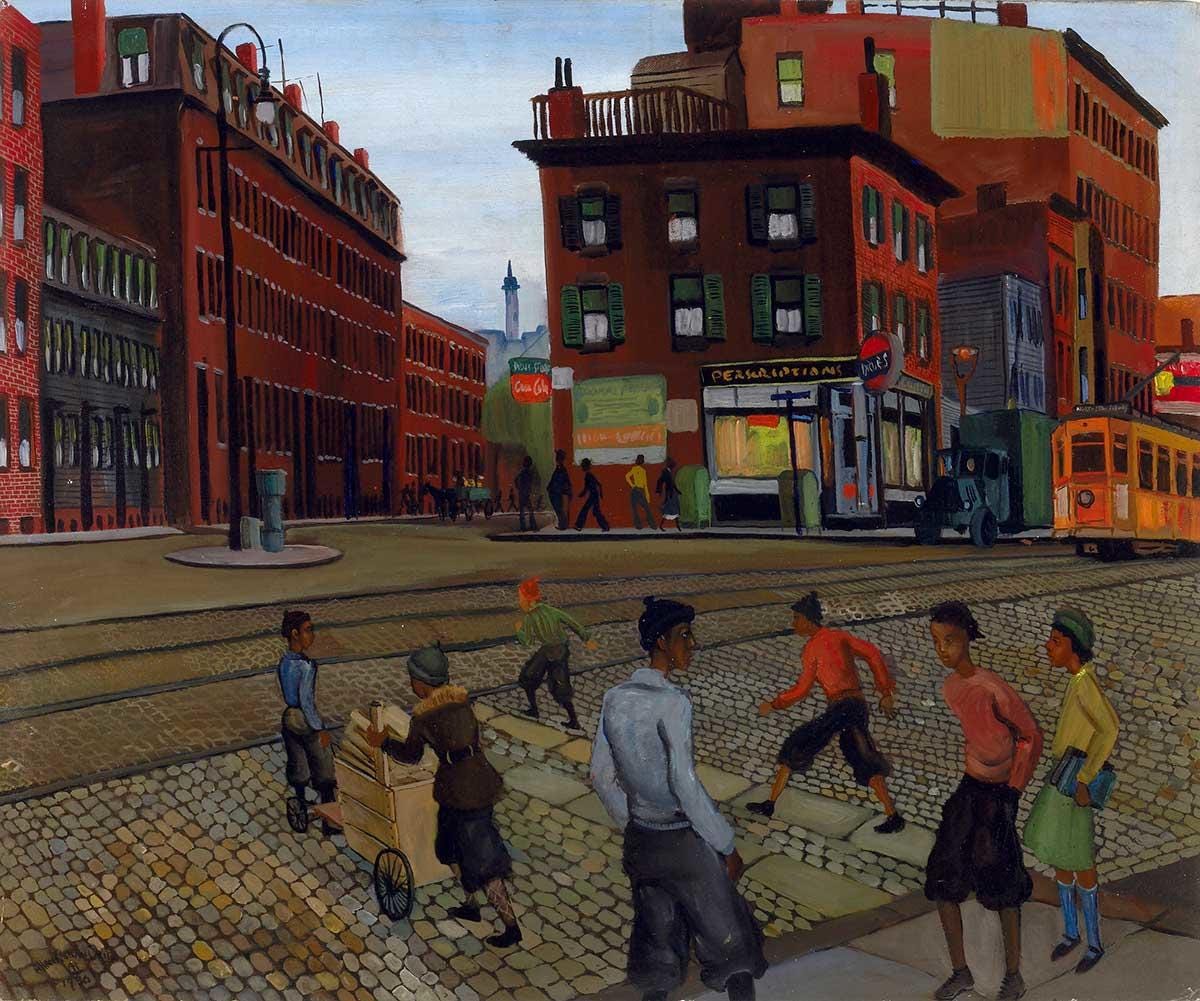
LLW: Wow! What a connection to the space.
DG: Then there is the permanent collection.
LLW: We haven’t even talked about that yet! How do you all think about conservation in a museum that is generally not changing and works are not going off view?
DG: It’s a great question. We have a Collection Management database, like other museums, and a team of technicians who work on cleaning the collection every Tuesday and do things like dust a particular gallery or even clean the mosaic in the central Courtyard.. We also have 5 full time conservators, and we all work together as it’s a constant effort to keep everything in the permanent collection the same.
LLW: Conservation is very cool. Interesting job.
DG: It takes such concentration. They’re amazing.
LLW: Agreed…On to my classic Art Apéritifs questions. What are you currently obsessed with?
DG: What I’m currently obsessed with? [Thoughtful sigh] Right now I'm obsessed with how the exhibition process, I was describing before, how we can deepen that commitment. How is being a curator about sharing your platform? And making sure the Gardner is a place that features many voices, not just mine and not just Isabella’s, for that matter. So that’s really what I am passionate about, interpretation and what responsible interpretation looks like. And in our permanent galleries, where we don’t have labels and can’t put up labels, present a lot of opportunities and challenges to ask ourselves, how do we ensure everyone has a great experience at the Gardner? And not come away frustrated that they don’t have all the answers, because I don’t have all the answers.
LLW: I love that, it’s okay to not have all the answers!
DG: Other than that, I suppose I’m obsessed with figuring out how to make my kid eat dinner!
[We both stop for a have chuckle]
LLW: Alright, final question: What is your favorite museum(s)? Or your favorite city for museums?
DG: Favorite museum? That’s such a hard question. There are so many incredible museums. [Thinking] I love the Barnes in Philadelphia and it is in many ways our sister museum, in the sense that it had a single founder and is a particular art experience…so it is interesting to compare and contrast the two.
I’m an Americanist by training. 19th century American art is mostly what I was trained in and I love the Farnsworth.
LLW: I’ve never been there.
DG: It’s in Maine, Rockland, Maine.
LLW: Oh! Cool.
DG: It has a lot of N.C. and Andrew Wyeth14 and it’s a lovely, wonderful museum. And then! It’s not an art museum, it’s a house museum, but the Louis Armstrong House Museum is amazing. It’s where he lived in Coolema, Queens in New York City and they have a wonderful program where they work with students from Queens College to be docents and you have to walk through with a guide. It is so well done.
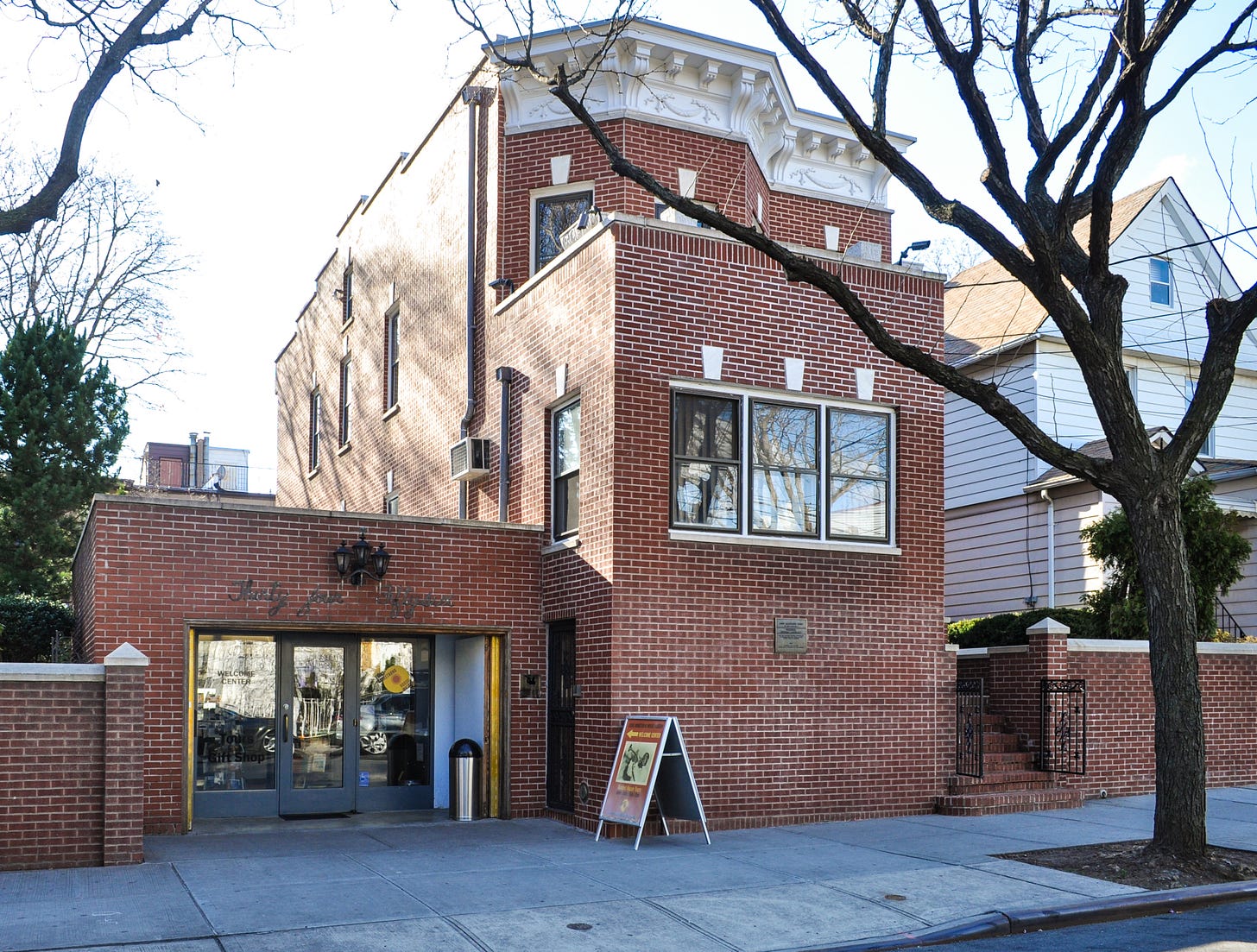
LLW: Incredible! I’ve never been there either but that is so cool!
DG: And it’s easy to visit, get on the subway, and then there is an awesome taco place nearby [laughs].
LLW: Yum. I’ll take my husband to the museum and taco spot, he’ll appreciate the cultural and culinary experience.
DG: That’s a whole other question…museum cafes.
LLW: Ooh do you have a favorite museum cafe?
DG: I think Storico15 at the New York Historical Society was really nice.
LLW: Oh [taking personal notes] okay. Anywhere else?
DG: Other good cafes? Minneapolis, the American Swedish Institute16, they have the best pastries, all these Scandinavian treats.
LLW: Are you going to these cafes for kicks?
DG: In this case, I was in Minneapolis on an extended layover a couple of summers ago and wanted to visit the museum- it’s a house museum - and coincidentally they have this incredible cafe, it’s delicious.
LLW: A pleasant surprise for the committed museum goer.
I meant it when I said to Diana that the Isabella Stewart Gardner Museum may be the best museum in the world. As I reflect back on my time with Diana and visit to the Museum I think I feel that way because it is a space that both inspires you to newness, new thinking, experiences, creators, while also encouraging you to be yourself. I found that one is completely at home within the Gardner. It’s like Isabella, and now Diana and her team are saying: come as you are, there is a place for you here.
Next time you’re in Boston, plan to visit the Gardner Museum, see here for details, and consider becoming a member to become further involved in their mission and programming both in-person and online. Big thanks to Diana and the entire team at the Gardner for welcoming me.
Reader, if you enjoyed this month’s Art Apéritifs, subscribe to 21st & 18th to read interviews with curators from around the world each month.

(1832 - 1883) French painter known for his contributions to Impressionism and Realism. Ever visited a big or French art museum? If so, you have certainly seen his stuff.
Diana is referring to Manet’s 1863 oil painting: Madame Auguste Manet, which hangs in the Blue Room within the Isabella Stewart Gardner Museum.
(1829 - 1906) Born Suzanne Leenhoff
Diana is referring to Locke’s title, Manet and the Family Romance, see here to learn more and purchase.
A temple in Siem Riep, Cambodia that dates back to the 12 century and is said to be the largest religious complex in the world.
In the 17th - 18th centuries ‘The Grand Tour’ was the classic longer voyage through Europe with the goal of taking in the masters of the arts and classical scholars. Popular among aristocratic and upper class sets of people.
Acronym for Museum of Fine Art, the large classic art Museum in Boston
Curious? Diana is referring to: Pine Cone, 17th century, Carved marble. 18.7 x 15.2 cm (7 3/8 x 6 in.)Isabella Stewart Gardner Museum, BostonS9s12
(1856 - 1925) John Singer Sargent was an American artist well known for his portraits - he was close with the Museum’s founder, Isabella, throughout her life.
(1834 - 1917) Edgar Degas was a French Impressionist and Realist painter, best recognized by his depictions of ballerinas and dancers
Diana is referring to loans of art work, which is a popular practice of museums utilizing other museum’s collections or works of art from private collections to round out an exhibition.
(b. 1926) An American visual artist and storyteller, she’s still living and producing work and, I’ve found, her art quite provoking (in a positive way).
(1910 - 2007) Boston based Black artist who will be the focus of an upcoming show at the Gardner in 2025. See here for more information from the Smithsonian on him in the meantime.
N.C or Newell Convers Wyeth (1882 - 1945) was one of the most well known illustrators and his son, Andrew Wyeth, (1917 - 2009) was a visual artist known for his contributions to realism and regionalism. Both were American.
Sadly Storico closed in July 2023 however the New York Historical Society opened a new restaurant, Clara, in its place at the end of last year. See this Eater article for more details.



